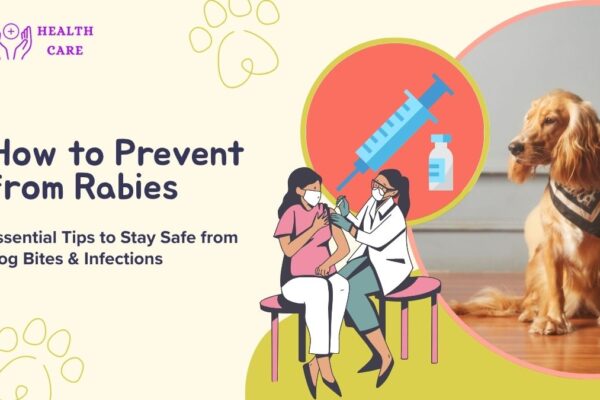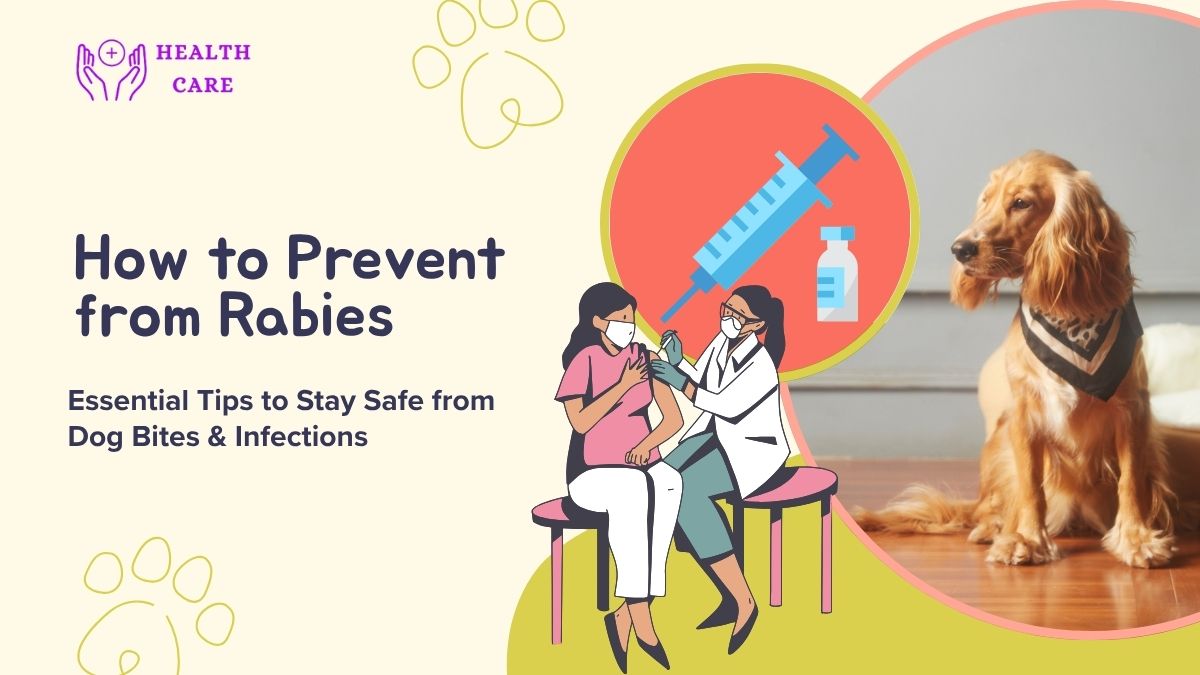Handling a dog bite To lower your risk of contracting a bacterial sickness, it’s critical to treat any wounds from a dog bite as soon as possible. To ascertain the extent of the injuries, you should additionally examine it. You may be able to treat yourself with first aid in certain situations. In other situations, you will require medical attention right away. After being bitten, you could feel uneasy, regardless of whether the dog belongs to you or someone else. Instead of driving oneself to the physician or hospitals if you require medical care, phone for assistance. Continue reading to find out what to do after being bitten by a dog and how to avoid getting infected.know how to prevent from rabies.
Inquire regarding the dog’s history of vaccinations. Putting separation among oneself and a pet is the initial thing you need to do after being bitten by one. By doing so, you can reduce the likelihood of getting bitten repeatedly. It’s crucial to find out if the animal has received a rabies vaccination once the danger has passed. Obtain the owner’s designation, phone quantity, and veterinarian’s connection details when you inquire about the dog’s immunization histories if they are in the area. Additionally, if at all possible, want to see identification.know how to prevent from rabies.
What happen on dog bites
If there is currently bleeding from the bite, cover the incision with a fresh cloth and apply light pressure to halt the flow. Apply antimicrobial lotion thereafter, and then wrap with a sterilized wrap. Even mild dog bite incisions ought to be closely watched for infectious symptoms until they have fully recovered. Check frequently to see whether the bite turns into: Warm and painful to the contact, swollen and red See a doctor right away if the injury worsens, you experience discomfort, or you’re given a fever.know how to prevent from rabies.
When to get assistance One out of every five dog bites necessitates medical attention. Seek medical attention for any dog bite that: is brought on by an animal that has an unclear history of receiving rabies vaccinations, acts strangely, or seems ill; doesn’t stop hemorrhaging reveals bone, ligaments, or muscles; leads to excruciating pain; results in loss of function, like a failure to bend fingertips; seems swelling, red, as well as inflammation; leaks pushed or water.know how to prevent from rabies.
Also seek medical attention if you:
Do not remember when you had your last tetanus shot
Feel weak, disoriented, or faint
Are running a fever
What are possible complications from a dog bite?
Dog bites can cause several complications. These include infections, rabies, nerve or muscle damage, and more.know how to prevent from rabies.
Infection
Bacteria can live in any dog’s mouth, including:
- staphylococcus
- pasteurella
- capnocytophaga
Dogs may also carry MRSA, but there have been no current reportsTrusted Source of it being transmitted via dog bite.know how to prevent from rabies.
These germs can cause bacterial infections if the dog bite breaks the skin.
However, get healthcare right away if the incision is serious and leaking constantly.
Consult a doctor if:
The skin was perforated or broken by the biting. The location is on an infant’s together, foot, or forehead. Your are worried about getting bitten. Although the insect bite is not severe, you should still see a physician inside eight days to be certain that are no diseases! Adolescents are greater susceptible to be attacked than grownups, and they are also greater liable to have severe wounds. Given that they’re particularly accessible body parts, studies indicate that a dog typically bites a person on their fingers, face, neck, or forehead.know how to prevent from rabies.
How Can Dog Bites Protect You Against Rabies?
Keeping as far toward unwanted pets as you can is the best defense against rabies. Be sure to immunize your pet dog against hepatitis if you have one at home. Although rabies vaccines are successful for 3 years, some veterinarians advise that dogs get rabies supplements annually. Go to an institution immediately if you are attacked by an outside dog that has not received the rabies vaccination. Giving a post-exposure preventative rabies vaccination can be required!know how to prevent from rabies.

What You Can Do As a Responsible Pet Owner
Vaccinate your animals.
Consistently vaccinations your pets reduces the likelihood of getting sick for both you and your neighbors in addition to preventing rabies. It lessens the possibility that they will bite someone or be attacked by an aggressive animal. Additionally, it aids in preventing rabies from spreading among animals habitats. Vaccines against rabies are administered by injection into your pet’s arm or leg. Regarding the suggested regularity and scheduling of rabies shots for pets, you should speak with a doctor.know how to prevent from rabies.
Keep an eye on your pet outside.
Avoid letting your pet go around or come into contact with untamed creatures. Keep your pet in a fenced-in area or on a leash. Steer clear of stray animals in particular dogs. To keep wild creatures from harming yourself, you should also lock up your pet food and garbage bins.know how to prevent from rabies.
Reduce the stray population
Call your local animal control centre to spay/ neuter stray animals from your neighbourhood. This will prevent unwanted litters and dog population from growing excessively. know how to prevent from rabies.
Watch out for wild creatures.
Avoid wild creatures like wolves, crickets, and others that can spread hepatitis. No wild creature ought to be fed, touched, or approached, particularly if it behaves violently or abnormally. In the event that you witness a creature behaving strangely, contact the neighborhood conservation department. Authorities can assist in capturing the creature, testing it for a disease called and taking the necessary precautions to safeguard the public’s welfare.know how to prevent from rabies.
Dog Reservoirs vs. Bats and Other Wildlife
The animals most likely to transmit rabies – what scientists call “reservoir species” – vary significantly depending on where you are in the world.know how to prevent from rabies.
In the United States, we’ve seen a dramatic shift over the decades. Thanks to successful vaccination campaigns, dog-mediated rabies has been largely eliminated. Today, our main concerns come from wildlife:know how to prevent from rabies.
Bats have become the leading cause of human rabies deaths in America, responsible for at least 7 out of 10 fatal cases. Raccoons dominate in the Eastern U.S., while skunks are common carriers in the Midwest and California, and foxes pose risks in parts of the Southwest and Alaska.
Interestingly, as the Cleveland Clinic points out, “In the U.S., cats are more likely than dogs to be rabid” – a fact that surprises many people.
The situation looks very different across much of Asia, Africa, and parts of Latin America. There, domestic dogs remain the primary threat, with dog bites causing over 95% of human rabies deaths globally. Stray and unvaccinated dogs create an ongoing public health challenge in these regions.
How Rabies Spreads Inside the Body
The journey of the rabies virus through your body after a dog bite and rabies exposure is both fascinating and frightening. Unlike many infections that race through your bloodstream, rabies takes a slower, more methodical approach.Know how to prevent from rabies.
First, the virus enters through broken skin or mucous membranes from infected saliva. It then multiplies in the muscle tissue near where you were bitten. Rather than rushing into your bloodstream, it seeks out nearby nerve endings and begins a steady march along your peripheral nerves toward your brain, traveling about 1-2 centimeters per day.
Once it reaches your brain, all bets are off. The virus replicates rapidly, spreads throughout your central nervous system, and eventually invades your salivary glands – ready to continue its lifecycle by infecting someone else.Know how to prevent from rabies.
The time between exposure and your first symptoms – the incubation period – can vary widely from just 5 days to more than a year, though it typically averages about 2 months.
Several factors influence this timeline:
- Bite location matters tremendously. Bites to your face or neck mean a shorter distance to your brain and a faster onset of symptoms – which is why facial bites are considered particularly high-risk.
- Wound severity plays a role too. Deeper wounds may introduce more virus into your system. The amount of virus transmitted and your age also affect the timeline, with children often developing symptoms more quickly due to their shorter nerve pathways.
- As veterinary experts explain, “The proximity of the bite to the central nervous system affects incubation speed.” This biological reality is why immediate medical attention is so crucial after any potential rabies exposure – especially for bites near the head.
First Aid & Incubation Timeline After a Dog Bite
Those first moments after a dog bite and rabies exposure can feel overwhelming, but knowing what to do might just save a life. Let’s walk through the critical steps you should take immediately – because when it comes to potential rabies exposure, every minute counts.
Immediate Wound Care Checklist
If you’ve just experienced a dog bite, don’t panic, but do act quickly:
First and foremost, wash the wound thoroughly. I’m talking about a good 15-minute rinse with soap and running water – this simple step washes away up to 90% of the virus particles. Use enough pressure to clean the wound, but be gentle enough to avoid scrubbing that might damage your tissues further.
After washing, applying an antiseptic like an iodine solution or even ethanol can provide extra protection against infection. If you’re dealing with bleeding, apply gentle pressure using a clean cloth until it stops.
Once the wound is clean, cover it with a sterile bandage. For deeper puncture wounds, though, be careful not to seal them completely – they need to heal from the inside out to prevent bacteria from being trapped.
“I can’t stress enough how important immediate washing is,” says Dr. James Wilson, emergency medicine specialist. “Those 15 minutes under the tap might feel excessive, but they’re potentially life-saving when dog bite and rabies exposure is concerned.”
Don’t forget to consider your tetanus protection too – if it’s been more than 5 years since your last booster, you’ll likely need another one.
Conclusion
A Few Things Regarding Rabies Once symptoms start to show, rabies is nearly invariably lethal. Avoiding exposure and getting medical help right away if you think you might have been exposed are the only ways for avoiding rabies. It is possible to diagnose rabies. Materials from the suspicious human or animal can be tested to identify rabies. Any creature bite or puncture should be reported right away to a medical professional. It is possible to eradicate rabies. Dog along with other creatures that can spread the virus to people can be vaccinated to eradicate this avoidable illness. By 2030, the World Health Organization (WHO) wants to see no humans fatalities from dog-mediated influenza.
Frequently Asked Questions
Q: How can I avoid dog bites?
A: Stay away from unknown dogs and don’t tease them.
Q: What should I do if a dog bites me?
A: Wash the wound with soap and water, then see a doctor immediately.
Q: Can rabies be prevented after a bite?
A: Yes, by getting rabies shots (PEP) as soon as possible.
Q: Do vaccinated pets still need care after biting?
A: Yes, report the bite and monitor the pet under vet guidance.
Q: Should pets be vaccinated for rabies?
A: Yes, regular rabies shots protect both pets and people.
Q: How do I know if a dog has rabies?
A: It may act strangely, drool a lot, or be aggressive.
Q: Can rabies spread without a bite?
A: Rarely, but it’s possible through saliva in open wounds or eyes.










